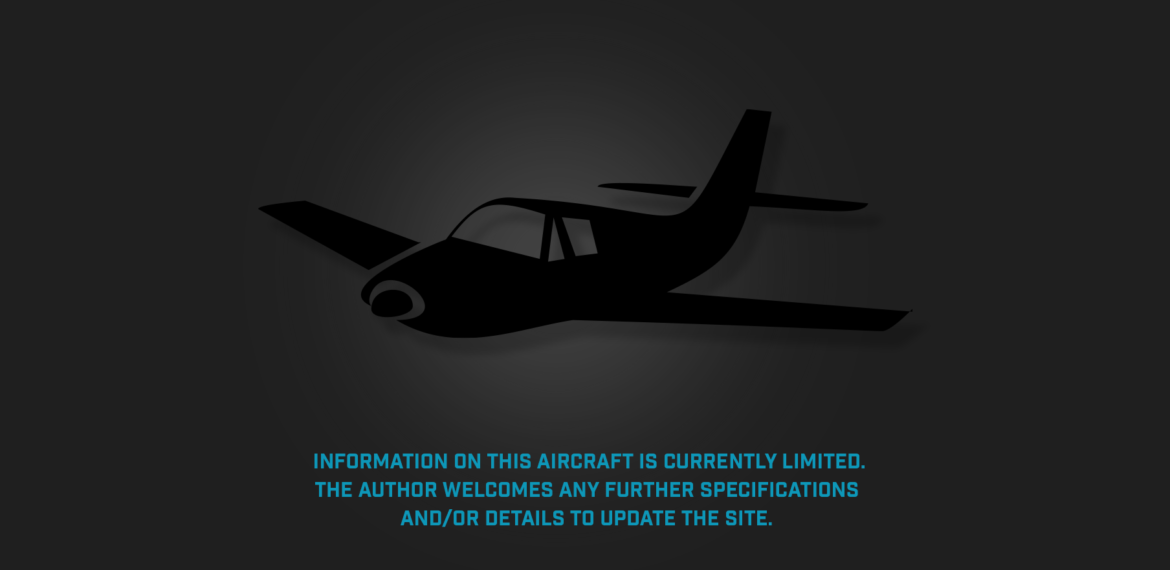Photograph:
Not available
Country of origin:
Australia
Description:
Military training and reconnaissance seaplane
Power Plant:
One 448 kw (600 hp) Pratt & Whitney R-1340 nine-cylinder air-cooled radial engine
Specifications:
- Wingspan: 14.47 m (47 ft 6 in)
- Wing span with wings folded: 5.33 m (17 ft 6 in)
- Length: 11.58 m (38 ft)
- Height on beaching gear: 5.33 m (17 ft 6 in)
- Wing area: 32.05 m² (345 sq ft)
- Max speed at 1,981 m (6,500 ft): 298 km/h (185 mph)
- Max speed at sea level: 280 km/h (174 mph)
- Cruising speed at 1,981 m (6,500 ft): 233 km/h (145 mph)
- Initial rate of climb: 533 m/min (1,750 ft/min)
- Service ceiling: 7,315 m (24,000 ft)
- Landing speed: 84 km/h (52 mph)
- Fuel capacity: 324 litres (125 Imp gals)
- Normal loaded weight: 3,030 kg (6,680 lb)
- Max overload weight: 3,348 kg (7,380 lb)
Armament:
Two 7.69 mm (0.303 in) Vickers Mk V machine-guns with 1000 rounds firing foward; to the rear two 7.69 mm (0.303 in) Lewis machine- guns with 970 rounds; bomb load of up to 227 kg (500 lb) externally; max bomb load 454 kg (1,000 lb)
History:
In the late 1930s the RAAF was operating a small fleet of Supermarine Seagull V biplanes for reconnaissance, air-and-sea-rescue, and general operations but was having problems keeping the aircraft airworthy. The wings were built of metal and, with operations on salt water, corrosion was causing problems. Two Department of Civil Aviation aeronautical engineers, Donald Stewart and George Birkbeck, were tasked to design wooden wing spars, ribs, wing tips and control surfaces for the Seagull wings in an attempt to keep the aircraft in service and extend their service life.
Whilst working with the design a request was made that the engineers design a new wing, including a complete mainplane, tailplane and rudder, the new parts to be manufactured in Australia. By 20 February 1941 test spars had been fabricated and delivered to the Commonwealth Scientific and Research Department for testing. At about this time the engineers raised the question of a replacement aircraft and, as a spare-time venture, they designed a new floatplane, being a single float aircraft to be known as the SR-1. The aircraft was considered to be faster and more effectively armed, occupying the same shipboard stowage space on board Australian Navy ships as the Seagull V, being able to operate if need be as a dive bomber, and being able to be catapulted from cruisers of the Royal Australian Navy.
A proposal was submitted that the team could produce a prototype of the new design, which could be completed in nine months at an estimated cost of £20,000 ($40,000). However, due to pressures of other work at the time early in World War II, the proposal was shelved for a period until the Air Board was actually considering the replacement of the Seagull V. The project was then presented for consideration on 20 August 1941.
Work on the project continued for some time, extensive use being made of components then being built for the CAC Wirraway, including the engine installation, cockpit enclosure, which would have been extended to include a third crew member, instrumentation, fuel tanks, armament installation, hydraulic system, flight and engine controls, and electrical components.
The fuselage was to be of welded steel tube frame from the firewall to the rear cockpit, then changing to wooden semi-monocoque construction to the rear, with the tail unit being of wood. The wings were also of wood, with a hydraulic folding mechanism for stowage. Wood to be used in the construction was to be Australian Mountain Ash, with coachwood ply covering on the whole aircraft. Control surfaces were to be fabric covered. The single float was to be of moulded phenolic resin-bonded plywood, but aluminium was specified as an alternative if supplies became available. The fuselage pylon was to have a locker for the mooring equipment.
Forward armament was to be two fixed Vickers Mk V machine guns and to the rear were to be two Lewis machine-guns. The aircraft could carry a bomb load of up to 454 kg (1,000 lb) if a smaller fuel load was carried.
On 25 October 1941 the Australian Minister for Air, Arthur Drakeford, advised the Air Board that the proposal had been investigated but it had been decided it was not a practical proposition and was not thought to be a suitable replacement for the Seagull V. Further, the expense of development of a prototype was not considered to be justified, particularly as Supermarine in the United Kingdom was developing a replacement for the Seagull V, this being the Sea Otter, which also was a radial engine biplane. At that time also Supermarine Walruses were becoming available from the United Kingdom, the Walrus being a development of the Seagull V, and the RAAF ended up with a fleet of Walrus and Sea Otter aircraft later in the war.

